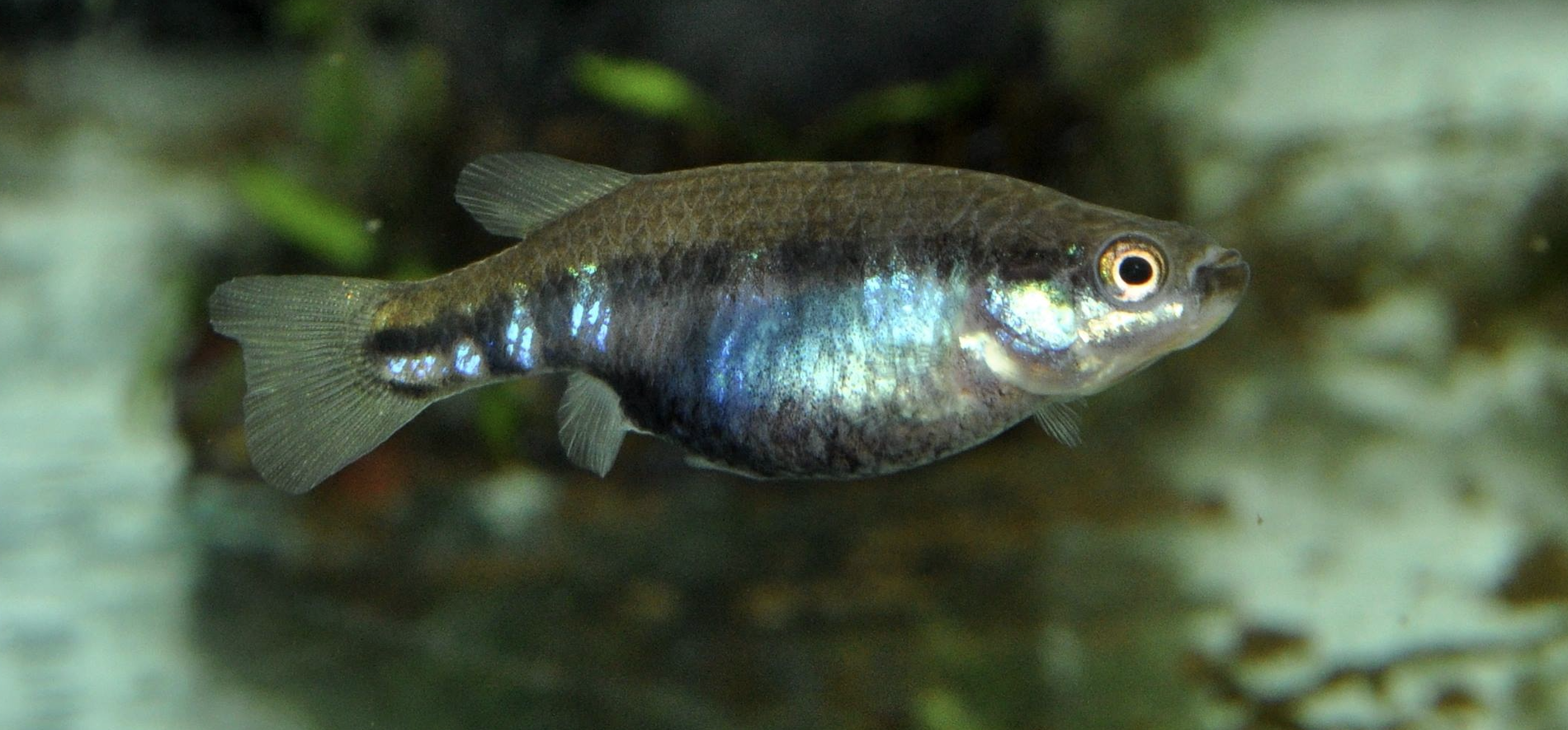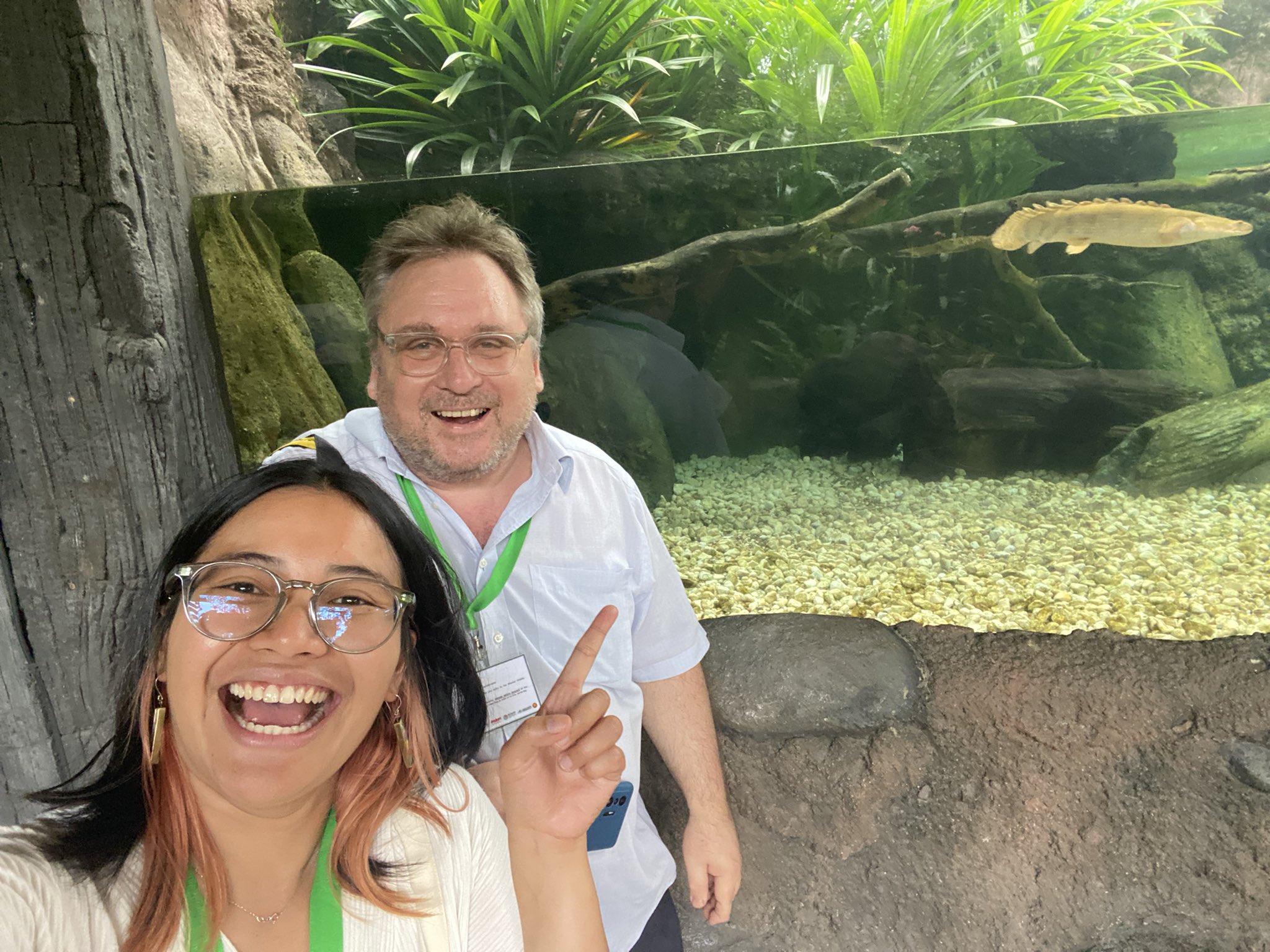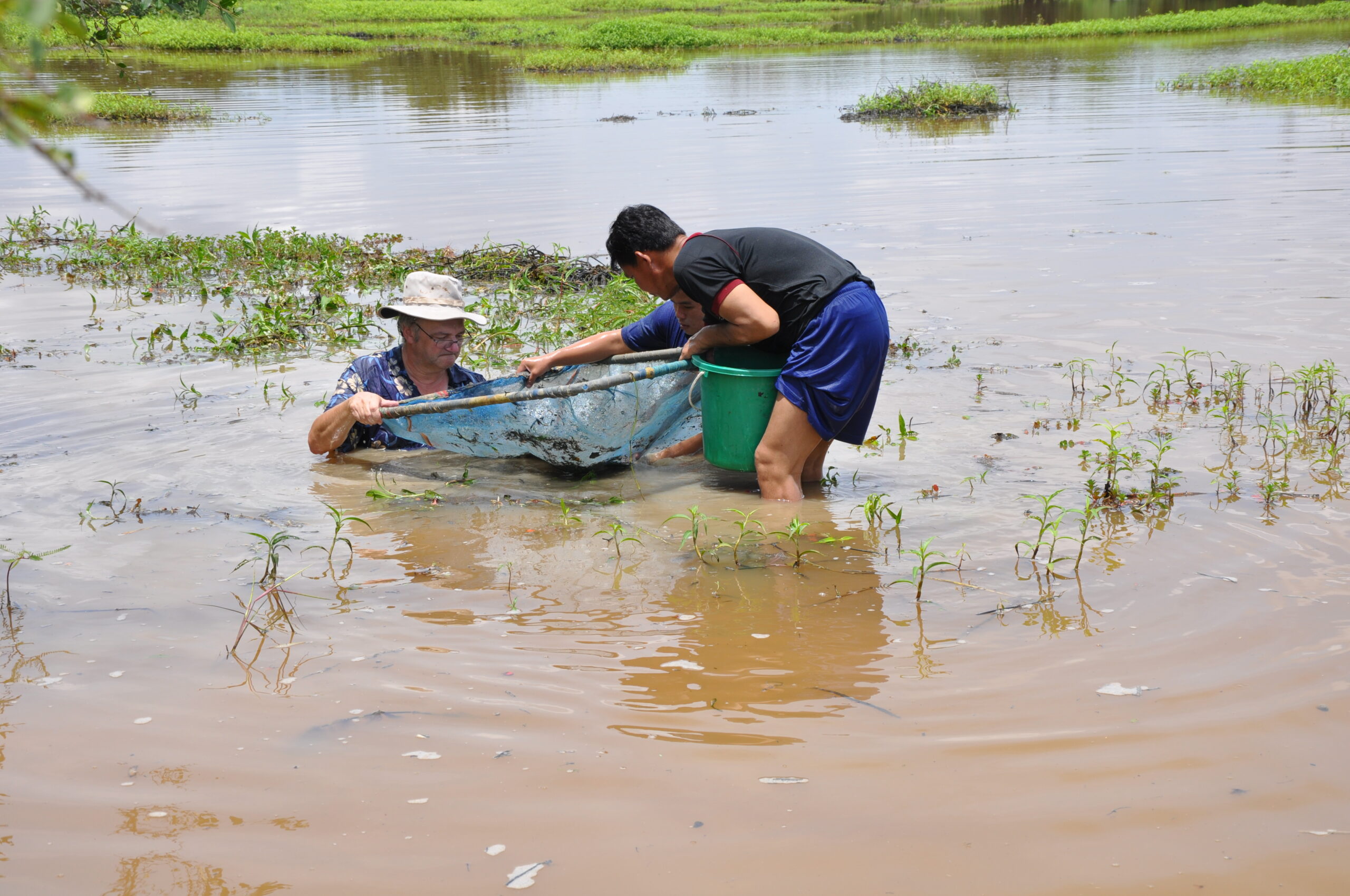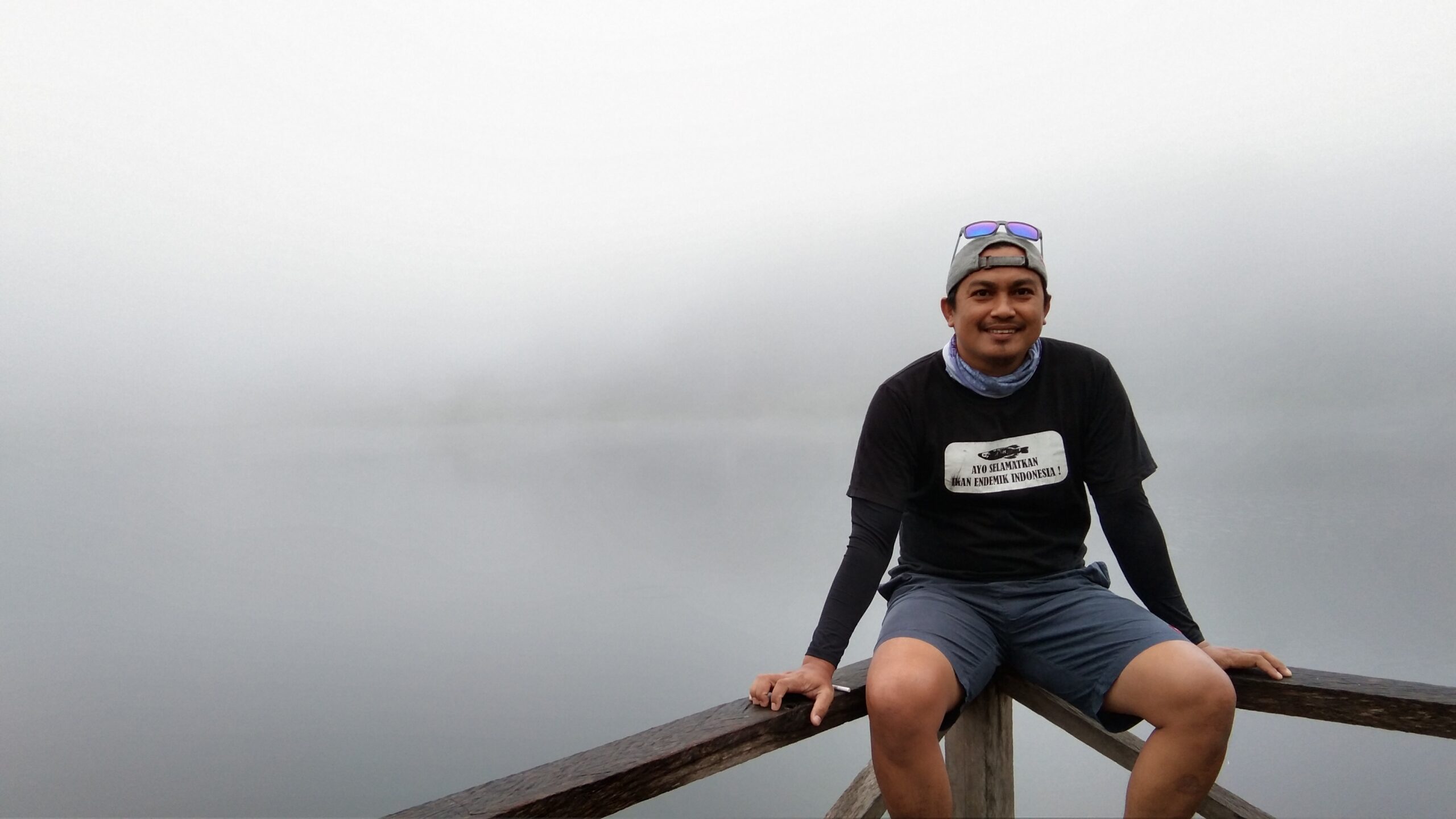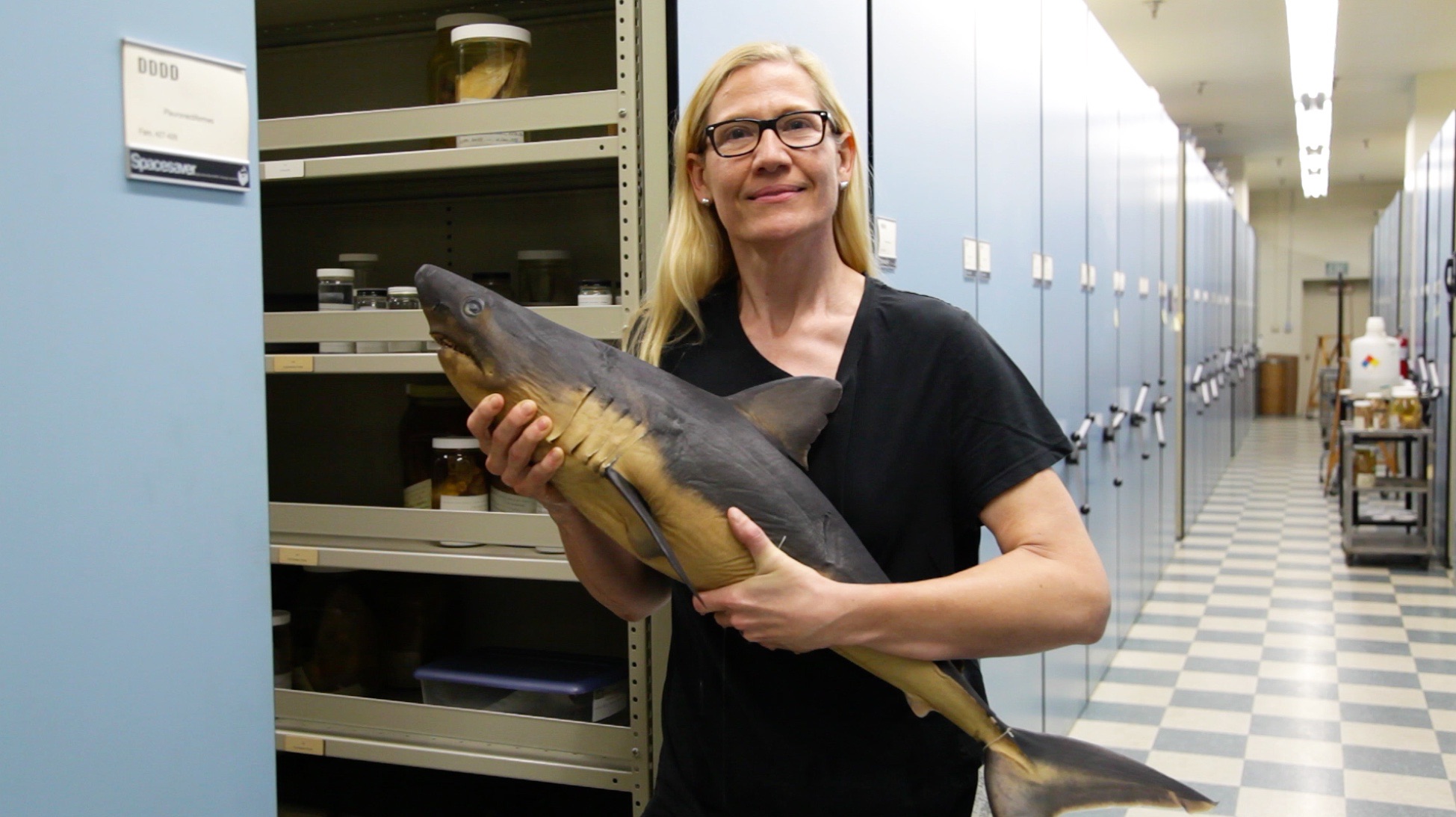Talking Sawfish: Interview with Michael Grant
(c) Fish and Wildlife Research Centre
by Michael Grant and Merlin Veron
Why Sawfish?
Evolutionarily, sawfish are very interesting, The toothed rostrum of sawfish make them a very unique member of the Chondrichthyes (sharks, rays, and chimaeras). There are five species of sawfish. The smalltooth sawfish, Pristis pectinata is found only in the tropical coastal waters of the Atlantic Ocean, while the dwarf Pristis clavata, green Pristis zijsron, and narrow Anoxypristis cuspidata sawfish species are found only in tropical waters of the Indo Pacific region. Meanwhile, the largetooth sawfish Pristis pristis is found globally throughout the topics.
Unfortunately for sawfish, they are one of the most threatened families across all sharks and rays. This is largely because their toothed rostrum (or ‘saw’) is very easily entangled in fishing nets. They are particularly susceptible to gillnet and trawl fisheries, which are the most common commercial fishing activities in estuaries and coastal regions where sawfish live. In recent decades, sawfish have experienced significant population declines and some species have lost up to 80% of their historic distribution. Presently, all species are either Endangered or Critically Endangered on the IUCN Red List of Threatened Species.
So there is an urgent need to focus conservation efforts on identifying where the last refuges for these species are, and to try and understand how sawfish interact with the local people in order to identify threats to these remnant populations. It would be a shame to lose such an amazingly distinct animal.
What is your research trying to discover?
Our research focuses on sawfish in Papua New Guinea, although we are also documenting other species of shark and ray as we go. While it was thought northern Australia was the last major multi-species refuge for the four Indo-Pacific sawfish species, it appears there may still be viable populations in Papua New Guinea also. Recently in 2014, my PhD supervisor Dr. William White discovered all four Indo-Pacific species still present in Papua New Guinea’s Western province when examining dried shark fin during a short visit to the region. This prompted a major research expedition throughout Papua New Guinea to try and discover where viable populations may be, which is what we are currently working on. Primarily we search for rostra around villages, as the rostrum is often kept for decoration in villages houses. Additionally, we have designed a questionnaire for local fishermen to gather information on how sawfish fit in the livelihoods of local people (e.g. if they are culturally significant), and whether fishermen have noticed a change in their population numbers over time.
We have also found lots of river sharks Glyphis spp. River sharks occur in freshwater also as juveniles, becoming more marine as they grow larger. These sharks are also endangered so it has been nice to find pockets where population numbers appear to be quite high.
When do sawfish use freshwater, and what sort of habitat conditions do they require?
Sawfish typically use lower salinity environments within tropical river systems when they are younger. This may be an adaption to avoid large marine predators, and also avoid competition from other shark and ray species that occur in coastal waters during their vulnerable juvenile years.
While all sawfish species occur in non-marine environments (salinity less than 30ppt), only the largetooth sawfish can tolerate freshwater (salinity less than 5ppt) for prolonged periods. Studies in northern Australia have shown that largetooth sawfish spend their first four to five years in the upper reaches of rivers, accessing floodplains opportunistically as they grow. They then move down into the estuaries and out into marine waters (salinities greater than 30ppt) around river mouths and shallow inshore areas as they become adults. The other species have a similar pattern of habitat use as they grow, except they do not occur in freshwater for long periods. Rather, juveniles use estuaries as nursery grounds, generally moving into more marine environments as they grow larger.
The trouble with this strategy of using both non-marine and marine environments during their life cycle is that it compounds their exposure to human pressures. These pressures include not only fishing, but also river engineering (canals, dams, irrigation etc) and habitat degradation. Most sharks and rays only use marine environments, and these extra pressures that sawfish face are further reasons why sawfish are among the most endangered shark and ray species.

Michael Grant conducting an interview with local fishermen at Goare Village in the Kikori River Delta (c) Darcy Roeger
Just how do sawfish use their rostrum?
The rostrum has three main functions. Besides the obvious defence benefits that a sharp saw on one’s face would offer in shallow estuarine and inshore environments full of crocodiles and sharks, the rostrum is also used for feeding in two ways. Much like swordfish use their bill to stun schooling baitfish, sawfish have been observed rapidly waving their rostrum in schooling prawns and baitfish. The rostrums secret weapon however lies not in its sharp teeth, but rather a sixth-sense in small pores on its underside. All sharks and rays have pores around their mouth called ampullae of Lorenzini (first described by Stefano Lorenzini in 1678). These pores are interconnected and filled with a conductive jelly-like substance that acts as an electo-magnetic receptor. All living animals give off minute electric fields as a result of their bodily functions. These special ampullae of Lorenzini can detect these electrical signals, allowing sharks and rays to find prey that they cannot otherwise see (i.e. invertebrates and fish buried in sand). Sawfishes have a high concentration of ampullae of Lorenzini under their rostrum and they use it like a large metal detector to find food. This is a very critical adaption in the highly turbid rivers in which they live, as visibility is very low, and eyesight is not reliable enough to locate food alone.
When sawfish are caught in nets, the thrashing around of their rostrum in attempts to escape often results in damage to fishing gear. Because of this, some fishermen see sawfish as a pest, and sometimes cut the rostrum in order to untangle and discard the animal from their nets. While thankfully this practice is not considered to be common, starved sawfish that have had their rostrum cut off have been observed in northern Australia, indicating the crucial role the rostrum plays in sawfish feeding habits.
What’s your favourite fact about sawfish?
Probably the adaptability in the physiology of their blood. Weird, but first let me take you back to high school biology and explain. Fish (including bony fish, and sharks and rays) evolved in marine water. Because marine water is salty (and saltier than blood), fish lose water and absorb salt from the environment by osmosis and diffusion, respectively. To combat this, they have to drink constantly, and continuously excrete salts. If their blood gets too salty, it disrupts their nervous system and brain function.
In freshwater they have the opposite problem. They absorb water from the environment and loose salts. This means they don’t drink and retain salts as best as they can which they mainly obtain from food. If they loose to much salt, it also disrupts their nervous system and brain function. For fish that live in marine environments, they have adapted to have quite salty blood to help alleviate the ‘salt gradient’ between their blood and their environment so that they have less work to do in maintaining a balance.
Sharks and rays on the other hand have taken a different approach to the problem. They retain nitrogenous compounds in their blood, so that their overall blood salt level is loosely equal to their marine environment. The benefit of this is that they don’t loose much water by osmosis, and therefore sharks and rays generally don’t need to drink! The only problem they have is excreting salt. Unlike bony fish, sharks and rays have a special gland called the salt gland, that helps them remove excess salt from their body.
For sharks and rays this is a great adaption to marine environments, though it limits their ability to live in freshwater. For bony fish in freshwater, generally all they have to do is decrease the saltiness of their blood, so that they don’t absorb more water than the amount of urine their kidneys can produce. For sharks and rays however, they have the extra baggage of dissolved nitrogenous compounds in their blood. They have to reduce their blood salts, though keep enough for their nervous system to work, although they can’t lower their nitrogenous compounds too much. This means that in freshwater, they absorb lots of water because of the difference between their blood and the environment. They also have a very difficult time not losing all their salts through diffusion out of their gills. For this reason, there are only 43 rays that have been able to adapt to live in freshwater for their whole lives (most of which no longer have dissolved nitrogenous compounds in their blood), only 10 species of shark and ray that can occur in both freshwater and marine. The other 1200 species of sharks and ray stick to marine environments. Comparatively, around 40% of bony fish species (~15 000 species) occur in non-marine environments either full- or part-time, because this transition into freshwater is much easier for them. So the fact that sawfish can tolerate non-marine environments, and alter their blood chemistry to suit the environment type they are in is very special! We don’t entirely understand exactly how they do it at the biochemical level, though evolutionarily speaking, it’s quite a feat!

Michael Grant and Obiri, a local fisherman from Goare Village with the first confirmed account of the freshwater whip ray (Urogymnus dalyensis) in Papua New Guinea (c) Yolarnie Amepou
What is it that drew you to Papua New Guinea for your research?
What drew me to PNG wasn’t so much what we knew about the country but what we didn’t know! PNG is truly one of the last tropical wilderness areas on the planet. We know very little about what lives in its many river systems, and overall much of its coastline and riverine systems remain poorly documented. The second thing is the challenge that research in PNG presents. Outside of major towns and cities, there are no roads, limited airports, no sewage, no electricity and no running water. And to make things harder, crocodiles and disease carrying mosquitoes (including malaria) are commonplace, and wet season rainfall can be upwards of 10 metres. Accessing remote communities is a challenge within itself. Due to these challenges and inaccessibility, there a many discoveries to be made, and that’s what drives me to keep going back.
PNG is known for its birds of paradise and tree kangaroos, but what are its freshwater systems like?
The freshwater systems of PNG are truly remarkable. In the countries north, the Sepik River runs for more than 1,000km making it one of the longest tropical rivers in the world. Meanwhile in the Gulf of Papua in PNG’s south, the Fly, Bamu, Turama, Kikori, Wabo and Purari Rivers all drain into Gulf. These rivers are high flow and incredibly sediment rich, creating a highly turbid low salinity bay, perfect for sawfish. I’ve been lucky to travel up to the head waters of the Bamu, Turama and Kikori Rivers where conversely the water is crystal clear, flowing over volcanic rock through a labyrinth of dense rainforest. The natural beauty and shear expansiveness is truly hard to justify in words!

An expansive sand bank at the coast of Kikori River Delta. Shallow turbid sand banks are ideal habitat for all sawfish species (c) Michael Grant
Have PNG’s freshwater fishes been well documented, or do you think there are still many more to be described by science?
There have been only a few concerted expeditions over the years. The first assessment dates back as early as 1896, when the German botanist Carl Adolf Georg Lauterbach visited the Ramu River in PNG’s north (Lauterbach also collected the first sawfish specimen from PNG, a juvenile largetooth sawfish which is still preserved whole in the Museum für Naturkunde in Berlin). Since then there have been other surveys, while in more modern times the likes of Gerald Allen and David Coates have led extensive surveys throughout the 1980’s and 90’s, again largely focused on the Sepik and Ramu Rivers in the countries north. My PhD supervisor William White recently conducted a large shark and ray orientated project from 2014-2018. The project resulted in 132 documented species in PNG, 12 of which were previously undescribed.
That is what appeals to me about working in the Gulf of Papua. The rivers are so inaccessible that I’m sure there are many freshwater fish waiting to be discovered throughout the multitude of floodplains, creeks and tributaries. For example, in late 2018 we confirmed a species of freshwater whipray, Urogymnus dalyensis, at the mouth of the Kikori river. This species was formerly only known in northern Australia.
What’s the most breathtaking/jaw-dropping moment you’ve had while on your expeditions?
The whole experience is quite amazing. Travelling down the Fly River was certainly up there. We passed about 400km of floodplain stretching to the horizon on either side of the river. The volume of freshwater habitat was incomparable to anything I’ve ever seen.
What is the most hair-raising moment you’ve had while on your expeditions?
The standout ‘only in PNG’ moment would have to be having a cassowary (a large aggressive flightless bird endemic to PNG and northern Australia) interrupt our assessment of the mornings catch during a visit to Kopar Village at the Mouth of the Sepik River. It turns out the cassowary was actually a semi domesticated ‘pet’ of one of the local villagers, though it was a hair-raising experience for a while there! Other experiences have included crossing sand bars at the mouths of rivers on a 20ft banana boat during 2m plus swells with the outflow of rivers providing a strong undercurrent. When you are 200km from civilisation seriously thinking about ‘if we capsize here, where can I swim to and if I make it, then what?’ it certainly gets the heart rate up! The skippers however drive those sort of conditions regularly, and they never seem too worried.

A cassowary holds up assessment of the overnight shark catch, Kopar Village, Sepik River (c) Michael Grant
What advice would you give young conservationists trying to research and protect rare and unique fish?
Admittedly, it can be a hard space to get into. There is often limited funding for such research and usually a bit of luck is required. I think volunteering is a great way to start out, and importantly not being afraid to reach out and offer assistance however you can. I’m a big believer in the old adage ‘it’s not what you know, it’s who you know’. If you are not meeting and talking to people, it’s hard to get anywhere! I think social media is a good platform, lots of scientists are on Twitter. Starting a professionally orientated account has paid good dividends for me personally. For undergraduate or postgraduate researchers, attending conferences in also important. For me, actually presenting a poster or talk comes secondary to having the opportunity to meet people. That being said, pick a conference that will attract the type of people you want to meet. Lastly, recognising that management of fisheries is not about managing the fish, it’s about managing the people. This cannot be overstated enough. I think social sciences, and studying how animals fit into the livelihoods of people is still in its infancy. There’s lots to learn and any conservation orientated project needs to include the local people.
What’s next for you and the wonderful sawfish you study?
A dangerous question to ask a mid-end term PhD candidate! It’s all a bit of an unknown at this point (for me and sawfish!). I’ve got a few things lined up to continue working in Papua New Guinea. There is lots of capacity building required to get things moving over there, and I’m fortunate to have good relationships with the University of Papua New Guinea and Provincial Fisheries officers. Gathering information to inform fisheries management plans is what the focus will be moving forward. If we can develop some sort of legislation to protect sawfish that would be fantastic, although community based awareness measures are probably more realistic in the short term. I’m planning on writing a children’s book to distribute to remote communities in PNG which will help inform people on sawfish, and concepts of overfishing. Taxonomic research is also high on my future agenda. I’m lucky to research under Dr William White at Australia’s National Fish Collection so we’ll see what happens. 10 years from now I’d like to be pulling the strings in my own lab, but for now its about completing research projects and ticking boxes.
The author would like to acknowledge and specifically thank William White for giving him the opportunity to work in Papua New Guinea and to his other PhD supervisors, Andrew Chin, Colin Simpfendorfer and Peter Kyne. Thanks also to Save our Seas Foundation for funding our research, and to the PIKU Biodiversity Network for their contribution to our project. Interested readers can stay up to date through the twitter account @Mickkgrant

